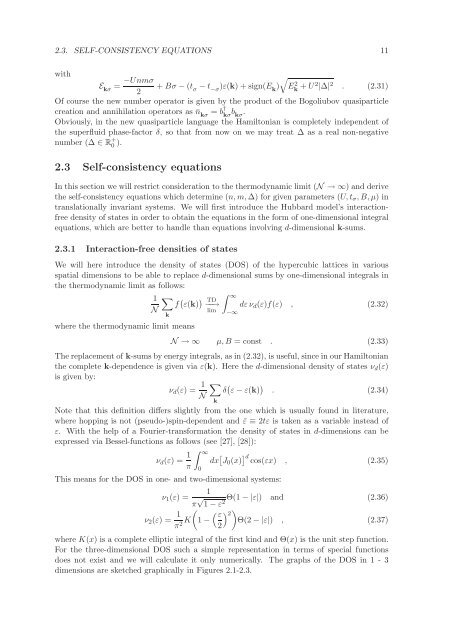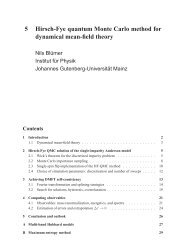Hubbard Model for Asymmetric Ultracold Fermionic ... - KOMET 337
Hubbard Model for Asymmetric Ultracold Fermionic ... - KOMET 337
Hubbard Model for Asymmetric Ultracold Fermionic ... - KOMET 337
You also want an ePaper? Increase the reach of your titles
YUMPU automatically turns print PDFs into web optimized ePapers that Google loves.
2.3. SELF-CONSISTENCY EQUATIONS 11withE kσ= −Unmσ√+ Bσ − (t2σ− t −σ)ε(k) + sign(E k) Ek 2 + U2 |∆| 2 . (2.31)Of course the new number operator is given by the product of the Bogoliubov quasiparticlecreation and annihilation operators as ¯n kσ= b † kσ b kσ .Obviously, in the new quasiparticle language the Hamiltonian is completely independent ofthe superfluid phase-factor δ, so that from now on we may treat ∆ as a real non-negativenumber (∆ ∈ R + 0 ).2.3 Self-consistency equationsIn this section we will restrict consideration to the thermodynamic limit (N → ∞) and derivethe self-consistency equations which determine (n,m,∆) <strong>for</strong> given parameters (U,t σ ,B,µ) intranslationally invariant systems. We will first introduce the <strong>Hubbard</strong> model’s interactionfreedensity of states in order to obtain the equations in the <strong>for</strong>m of one-dimensional integralequations, which are better to handle than equations involving d-dimensional k-sums.2.3.1 Interaction-free densities of statesWe will here introduce the density of states (DOS) of the hypercubic lattices in variousspatial dimensions to be able to replace d-dimensional sums by one-dimensional integrals inthe thermodynamic limit as follows:1N∑where the thermodynamic limit meanskf ( ε(k) ) ∫ ∞TD−−→ dεν d (ε)f(ε) , (2.32)lim −∞N → ∞ µ,B = const . (2.33)The replacement of k-sums by energy integrals, as in (2.32), is useful, since in our Hamiltonianthe complete k-dependence is given via ε(k). Here the d-dimensional density of states ν d (ε)is given by:ν d (ε) = 1 ∑δ ( ε − ε(k) ) . (2.34)NkNote that this definition differs slightly from the one which is usually found in literature,where hopping is not (pseudo-)spin-dependent and ¯ε ≡ 2tε is taken as a variable instead ofε. With the help of a Fourier-trans<strong>for</strong>mation the density of states in d-dimensions can beexpressed via Bessel-functions as follows (see [27], [28]):ν d (ε) = 1 π∫ ∞This means <strong>for</strong> the DOS in one- and two-dimensional systems:0dx [ J 0 (x) ] d cos(εx) , (2.35)1ν 1 (ε) =π √ − |ε|) and (2.36)1 − ε2Θ(1 ν 2 (ε) = 1 ( ) ε 2(1π 2K − Θ(2 − |ε|) , (2.37)2)where K(x) is a complete elliptic integral of the first kind and Θ(x) is the unit step function.For the three-dimensional DOS such a simple representation in terms of special functionsdoes not exist and we will calculate it only numerically. The graphs of the DOS in 1 - 3dimensions are sketched graphically in Figures 2.1-2.3.













